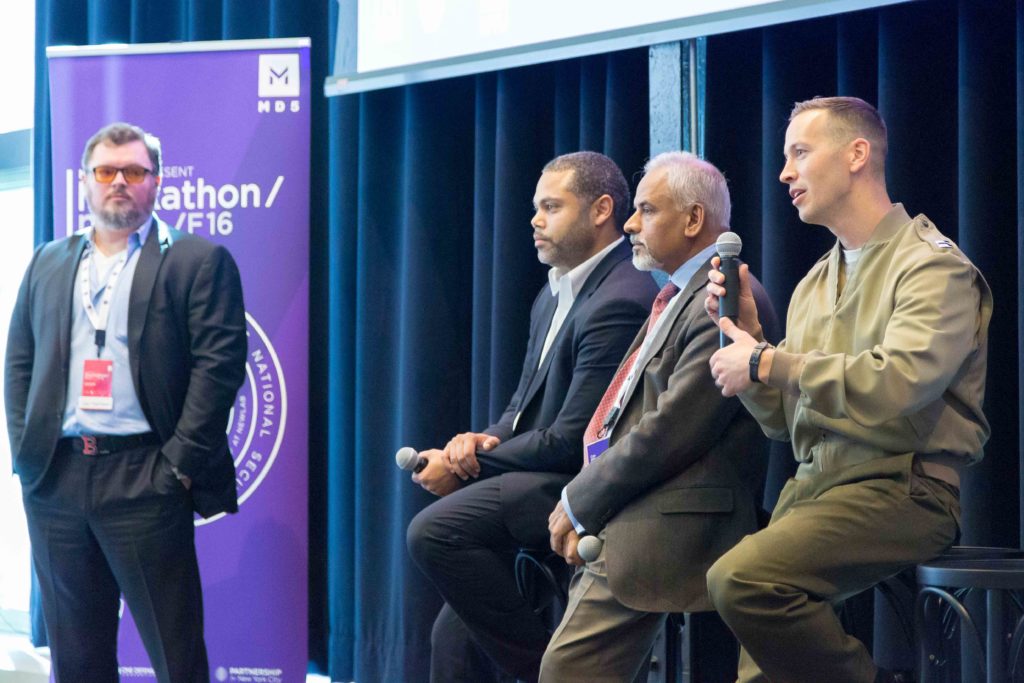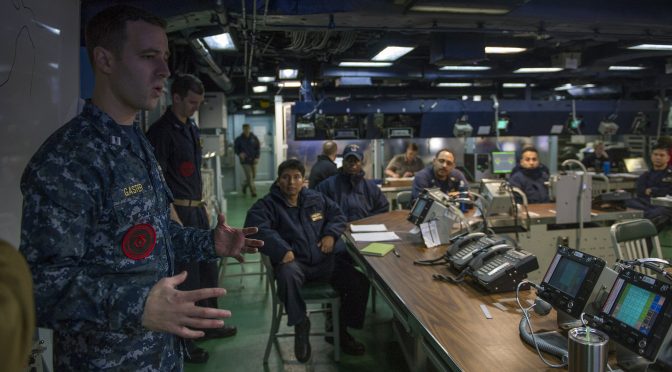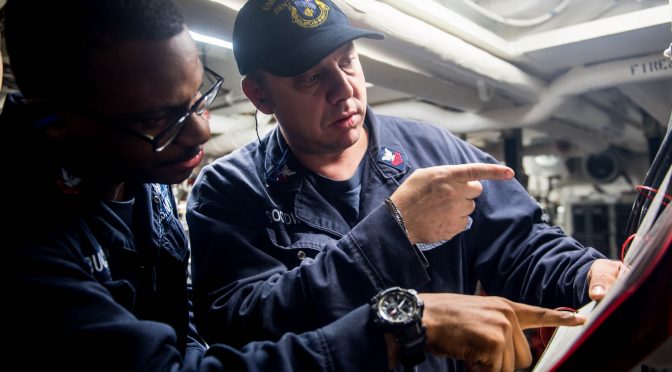Leadership Development Topic Week
By Joe Schuman
Introduction
What makes a leader? According to the Navy Leadership Development Framework (NLDF), effective leaders demonstrate qualities such as humility, honor, courage, commitment, integrity, and accountability. While few would disagree that these character traits are necessary for Navy leaders to be successful, the rapidly changing security environment of the 21st century makes it such that these skills are not sufficient. If the Navy is serious about producing leaders who will be “ready for decisive operations and combat,” it must place a stronger emphasis on promoting innovation throughout its leadership development process as a whole.
The definition of “innovate,” according to the Oxford English Dictionary, is “to make changes in something established, especially by introducing new methods, ideas, or products.” Innovation, therefore, is essentially a problem solving technique, which can be applied to any number of problem areas – technical, policy, process, and more. Note that innovation is not limited to technological innovation and is distinct from invention – the creation of a new technology. In the context of leadership development, an innovative leader is someone who is forward-leaning, willing to challenge the status quo, and possesses the ability to create value in new ways for the organization to which they belong.
Innovation as a Necessary Warfighting Attribute
Interestingly, the NLDF clearly recognizes the need for innovative leadership. The opening sentence states, “our Navy’s operational and warfighting success requires that we be ready to prevail in an environment that is changing quickly and becoming more complex.” Changing and complex problems cannot be addressed in the same manner as stagnant and simple problems, as the NLDF acknowledges when it stresses the importance of leaders who will “learn and adapt.” Nonetheless, the NLDF falls short of identifying innovation as a critical leadership quality. While the NLDF briefly notes the need for “initiative” and “creativity” in Navy leadership, innovation is only mentioned once within the entire document. In the “Developing Character” section, the NLDF notes that leaders should participate in “innovation opportunities.” Strikingly, this passing reference is included under “self-guided study,” not within the professional education or on-the-job training sub-sections, and is completely excluded from the “Developing Competence” section, as if innovation is not relevant to the competence of a Navy leader.
The deafening silence of the NLDF in regards to innovation is at odds with the military’s own history of innovative leadership. After the Normandy invasion in 1944, for example, American troops found that hedgerows frequently channeled them into ambushes. After discovering that the hedgerows were too thick to cut or drive through, American soldiers designed and welded a mechanism onto the front of their tanks that could successfully cut through the bushes.1 Innovation has historically also taken place on a larger scale. During the interwar period between WWI and WWII, exercises and wargaming at the Naval War College were used to inform actual decisions at the fleet level, which in turn informed the next round of exercises at the War College in an iterative loop. This ideation and testing process was not used to justify current doctrine but, rather, to reveal unanswered questions and possible solutions.2
Innovative leadership has proven its worth in recent conflicts as well. When National Security Advisor, Lt. Gen. H. R. McMaster, took command of the 3rd Armored Cavalry Regiment, he immediately changed a number of policies in order to better align his regiment’s operation with his own view (which was less accepted at the time) that “the key to counterinsurgency is focusing on the people.” McMaster took concrete steps to this end, banning the use of the term “haji,” mandating cultural understanding education for his troops, and setting up a system to poll detainees on how well they were being treated. As a result of these changes, trust began to develop between U.S. troops and locals which, in turn, resulted in thousands of Iraqis signing up to join the local police forces while preventative tips about insurgent activity surged. In the final analysis, because of McMaster’s innovations, U.S. military experts concluded that the 3rd ACR had conducting the best counterinsurgency among similar units operating in Iraq in 2005.3
Innovation also takes place on a smaller scale. For example, Chief Sonar Technician Benjamin Lebron, of the USS Fitzgerald, changed the way his division analyzes sonar data. Recognizing that he was spending a majority of his time constructing plots during Target Motion Analysis (TMA), Lebron created a TMA tactical decision aid, first in Excel, and then in HTML and javascript,4 that can spot sonar returns that look like submarine movements in real time. Now, Lebron’s code automates the redundant portions of his work, allowing him to focus on analyzing the relevant information instead of spending time drawing it, and, since it is web based, is easily scalable across the fleet.5
Although the aforementioned cases are promising, they are unfortunately the exception and not the rule. And while innovative military leadership has always been important, the increasingly rapid pace of technological innovation and ever-evolving face of conflict place a higher premium on innovative leadership than ever before. Joseph Thomas, Distinguished Military Professor of Leadership at the U.S. Naval Academy, notes that the current military environment, “calls for skill sets more consistent with the leadership of Lewis and Clark than Patton,” yet, “the military education and training structure that produced Patton remains virtually unchanged.” Thomas continues: “If the current and future battlefield can be characterized by an uncertain, non-uniform enemy, vague and rapidly changing missions, cultural sensitivity of warfighters, and a chaotic environment, then leadership development models crafted when there was a certain and predictable enemy, set leadership roles, and a proscribed methods of fighting must be changed.”6
Innovation Competencies
How, then, should the Navy promote the development of innovative leaders within its ranks? The key to answering this question is to understand the factors that influence the innovative competency of organizations as a whole and, by inference, determine the skills and qualities that leaders of these organizations need to posses. Building off the “Entrepreneurial Competency” framework proposed by Bharat Rao and Bala Mulloth in their paper “The Role of Universities in Encouraging Growth of Technology-Based New Ventures,” four competencies of innovative organizations emerge: (i) Opportunity Development, (ii) Championing, (iii) Resource Leveraging, and (iv) Location Leveraging.7 These qualities are essential for creating innovative organizations, and, as such, innovative leadership development programs must create leaders who can contribute to their organizations in these capacities. In the subsequent paragraphs, the MD5 National Security Technology Accelerator, a public-private partnership between the Department of Defense (DoD) and a network of national research universities that seeks to reinvigorate civil-military technology collaboration, will be used as a case study to illustrate examples of leadership development programs within Rao and Mulloth’s entrepreneurial competency framework.
The Opportunity Development Competency is defined as “the need to develop a viable business opportunity” in the context of university entrepreneurialism. It is related to “the knowledge and experience of the individual researcher,” which yields an “opportunity recognition capacity” in such individuals.8 In the context of the Navy, the Opportunity Development Competency requires individuals to (a) posses the methodological tools to frame problems, develop concepts, and make actionable recommendations and then (b) be exposed to new problems to which they can apply these skills. As such, in order to improve the innovative capacity of the Navy, Navy leadership development must (a) promote these skills and (b) create opportunities for the utilization of these skills.
One MD5 program, MD5 Bootcamp, serves as an example of the type of program that the Navy might want to consider implementing more broadly in order to foster the Opportunity Development Competency in its leaders. MD5 Bootcamp is a weeklong intensive education program that was first piloted in November 2016 with United States Pacific Fleet (PACFLT). It provides Navy leaders with the tools for problem framing and solving through a variety of lessons on topics such as design thinking and Lean Startup Methodology, and then encourages the application of these skills through exercises such as co-creation sessions. Future Navy programming should build off the success of MD5 Bootcamp in their professional education schools and formal on-the-job training.
The Championing Competency, in the context of university entrepreneurship, is defined as “the need for championing individuals who provide meaning and energy to the entrepreneurial process.”9 Champions are critical for promoting new ventures to relevant stakeholders, particularly at the early stages of venture development. Given the hierarchical structure of the military, the Championing Competency is even more important. Since innovation works best from the bottom-up, in contrast to the top-down structure of the military, the Navy must develop leaders at all levels who are willing to champion innovative ideas and push the limits of military hierarchy.
MD5 has made efforts to promote the Championing Competency within senior officers through classes like the Adaptive & Agile Leadership Network (AALN) at the National Defense University, which is an elective course that introduces agile-leadership approaches to innovation to mid-career military members. Other organizations, such as The Athena Project, which aims to harness grassroots innovations within the Navy through pitch events and mentoring, focus on creating innovators at the enlisted and junior officer levels. In combination, programs like AALN and The Athena Project create both innovation champions at the senior levels who subsequently promote innovation opportunities within their ranks, and innovators at the lower levels who champion their own ideas.
The Resource Leveraging Competency is defined as “the need to access the resources necessary to develop the new venture.” Rao and Mulloth note that the likelihood of launching university spin-offs increases as researchers have more access to facilities, financial resources, knowledge resources (e.g., intellectual property), and social capital resources.10 This competency is fairly analogous in the context of the Navy. Military leadership must, after recognizing an innovative opportunity, provide resources and access to promising ideas and personnel. Such resource leveraging may be within the purview of a given Sailor or their chain of command, or it may require the aforementioned championing competency to secure resources from higher levels of leadership.

MD5 has several efforts that encourage resource leveraging. MD5.net, for example, is a web-based platform that allows for the crowdsourcing, vetting, synthesis, and promulgation of problems, solutions, IP, and other innovation-enabling resources. Once fully operational, MD5.net will allow for resource leveraging between internal Navy and DoD innovators as well as civilian entrepreneurs. Other MD5 programs, such as the Proof of Concept Center and the University of Southern Mississippi, which provides digital design and manufacturing resources in support of distributed prototyping, and projected programs, such as MD5 Lab, which will provide innovators with prototyping and experimentation resources, aim to support this resource leveraging competency as well. The Navy must not only utilize existing tools and create similar programs for themselves, but also instruct leaders on how best to leverage both internal and external resources for the innovators within their ranks.
Lastly, the fourth and final competency, the Location Leveraging Competency, is defined as “the need to locate the new venture in the right ecosystem and support infrastructure.”11 In the context of Navy innovation and leadership development, the principal lesson from this competency is that the best ideas today don’t always live inside DoD and as such Navy leaders must be willing to work with non-traditional partners, especially the private sector.
MD5 Hack, a portfolio of hackathon events that brings together practitioners, technologists, and military members over a weekend to build prototypes, is built upon this principle. It is no coincidence that MD5 Hack has taken place in New York City and Austin, TX, and is going to be run in Boston, MA, as these cities harbor some of the best tech talent in the U.S., who bring their expertise to MD5 Hackathons to solve real DoD problems. Efforts such as DIUx, which has outposts in San Francisco, Austin, and Boston, also recognize the importance of the Location Leveraging Competency to solving DoD problems. Navy leadership must be willing to work with new partners through non-traditional approaches; Navy leadership development, therefore, must teach leaders to be willing to attempt new problem solving methods, particularly those that leverage the private sector.
Conclusion
Charles Darwin noted, “It is not the strongest of the species that survive, nor the most intelligent, but the one most responsive to change.” Yet, innovation is not considered a relevant leadership quality in the NLDF despite the clear need for innovative leaders in today’s conflicts. The Navy should be cautious not to bureaucratize innovation from the top-down and can do so by following Rao and Mulloth’s framework. And while current MD5 efforts represent positive progress towards the creation of the next generation of innovative leaders, these efforts will not be sufficient on their own. The Navy, and the DoD as a whole, must incorporate innovative leadership development into its standard leadership development programming. Such efforts can tie in with other promising programs and initiatives, such as the Chief of Naval Operation’s High Velocity Learning initiative.12 If done correctly, the Navy will empower the next generation of leaders to solve problems on their own, improving military effectiveness and success. If not, to adapt Roger Misso’s message, without innovative leadership, Alas Our Navy!
Joe Schuman is currently a Research Assistant at the MD5 National Security Technology Accelerator. Prior to MD5, Joe is a graduate from the Massachusetts Institute of Technology (MIT) where he studied Mechanical Engineering and Political Science. Joe also attended St. Peter’s College at the University of Oxford as a visiting student, where he studied Engineering Science as well as Philosophy, Politics, and Economics (PPE). Readers wishing to learn more about the MD5 National Security Technology Accelerator should contact Joe Schuman at joseph.schuman@gc.ndu.edu.
The views and opinions expressed in this article are those of the author and do not necessarily reflect the official policy or position of any agency of the U.S. government.
References
1. Tim Kane, “Why Our Best Officers Are Leaving,” The Atlantic, February 2011. Retrieved from https://www.theatlantic.com/magazine/archive/2011/01/why-our-best-officers-are-leaving/308346/.
2. Williamson Murray, “Innovation: Past and Future,” Joint Force Quarterly, Summer 1996.
3. Thomas E. Ricks, Fiasco: The American Military Adventure in Iraq (New York: Penguin Books, 2006).
4. “The A. Bryan Lasswell Award for Fleet Support,” National Defense Industrial Association. Retrieved from http://www.ndia-sd.org/wp-content/uploads/2017/01/LasswellAwards2015Program.pdf
5. Meghann Myers, “Top sailor innovations win big prizes,” Navy Times, March 2016. Retrieved from https://www.navytimes.com/story/military/2016/03/13/award-winning-ideas-navys-top-innovators/81443614/
6. Joseph J. Thomas, “Leader Development in the US Department of Defense: A Brief Historical Review and Assessment for the Future,” The ADM James B. Stockdale Center for Ethical Leadership – United States Naval Academy. Retrieved from https://www.usna.edu/Ethics/_files/documents/Leader%20Development%20History%20Thomas.pdf
7. Bharat Rao and Bala Mulloth, “The Role of Universities in Encouraging Growth of Technology-Based New Ventures,” International Journal of Innovation and Technology Management 14(4), January 2017.
8. Ibid.
9. Ibid.
10. Ibid.
11. Ibid.
12. John M. Richardson, “A Design for Maintaining Maritime Superiority,” January 2016. Retrieved from http://www.navy.mil/cno/docs/cno_stg.pdf.
Featured Image: U.S. Navy lieutenant speaks before sailors. (U.S. Navy photo)





